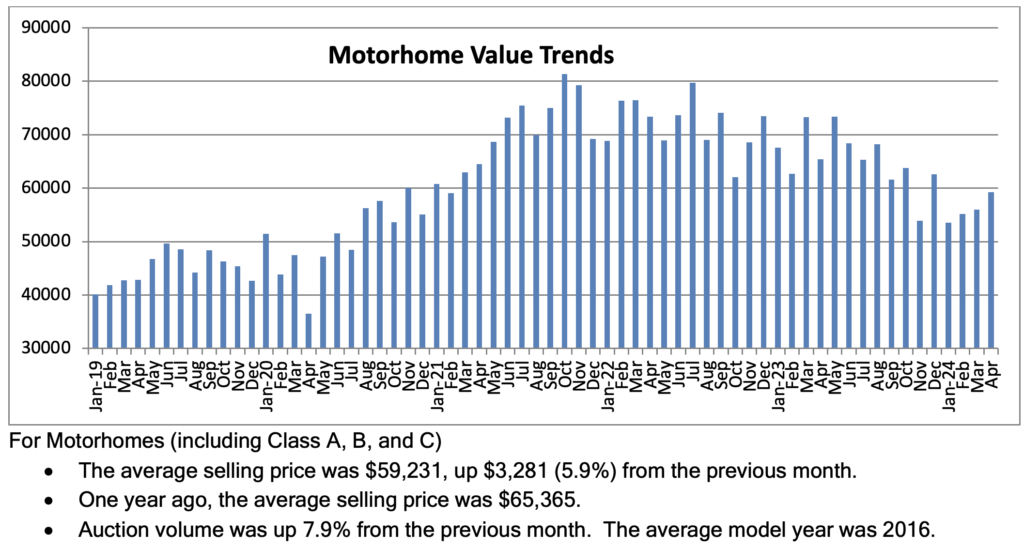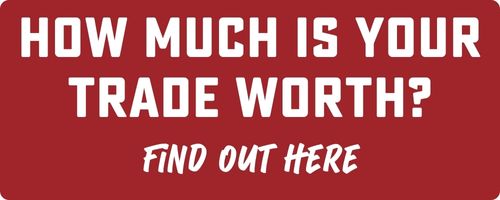Written by Greg Long

Have you been keeping up with the latest trends in the RV industry?
Interested in how the turbulent market ups and downs might impact your RV buying and selling decisions?
In this month’s RV Industry Sales Report for July 2024, we’ll look at the most recent RV dealer inventory projections, market health analysis, and the influence of external factors like fuel prices and interest rates.
Whether you’re a casual RVer, a potential buyer, or an industry professional, this rv sales report has up-to-date information to help you decide if now is the best time to buy or sell.
Get the total July 2024 RV Sales Breakdown from Josh the RV Nerd.
Table of Contents
Interested in selling your RV — let Bish’s RV sell it for you.
We do the work, you get paid.
New RV Sales
Understanding RV Shipments
RV shipments refer to the orders RV dealers place with manufacturers for new RVs.
These shipments reflect sales trends that RV dealers are noticing and give us insight into whether they anticipate selling more or fewer RVs in the near future.
- More Shipments: Indicates greater optimism from dealers, suggesting they expect strong sales.
- Fewer Shipments: Suggests a more negative outlook, indicating weaker sales expectations.
Current New RV Shipment Projections
Since December last year, projections have indicated a rise in RV shipments through the end of 2024 and into 2025.
These projections were initially based on the anticipated drop in interest rates and other key factors. However, despite interest rates holding steady, the RV Industry Association (RVIA) continues to predict an increase in shipments, citing “cautious optimism that the worst of the impact from interest rate increases is behind us.”
Latest Forecasts
- 2024 Shipments: The latest estimates suggest that around 330,000 to 359,000 units will be shipped throughout 2024.
- 2025 Shipments: The trend is expected to extend into 2025, with forecasts predicting between 374,000 and 408,000 units shipped.
Impact on New RV Sales
While these shipment numbers are promising, it’s essential to remember that shipments do not necessarily equate to sales.
There are various factors influencing the final purchase decisions of consumers.
Sales versus last year are down by approximately 10% to 17%, depending on the segment.
This decline has led some to question if we are experiencing a “Tesla effect,” where there is a high production volume but not as many units being sold off the lots.
Seasonal Trends and Inventory Management
The RV industry follows a cyclical pattern where dealers bulk up on stock to sell through the summer, leading to a buildup of inventory that dwindles in the fall and then bulks up again through the end of winter for the spring show season.
This cyclical nature often results in a temporary mismatch between build and sale rates.
- Current Inventory: Some companies are now only building 2025 models, stockpiling them in their shipping yards to meet the initial wave of dealer orders quickly.
- Prototyping and Releases: Other manufacturers are still producing 2024 models while prototyping their 2025 releases, with more updates expected to be seen from the end of July through August. By September, most 2025 models will be available.
RV Dealer Outlook
The number of shipments is a significant indicator of dealer optimism. Higher shipment numbers suggest that dealers are preparing for strong sales, while lower numbers indicate a more cautious approach.
Until the market stabilizes, it is challenging to predict with certainty how these trends will unfold.
However, the current projections from RVIA, adjusted for the steady interest rates, indicate a cautious but positive outlook for the RV industry in the near future.
What do you think about these updated projections? Do they seem realistic, or is RVIA aiming a bit too high with their estimates of 330,000 to 360,000 shipments for this year?
Share your thoughts and let’s discuss!
Like saving money?
Check out these Clearance-Priced Campers!
Used RV Sales
Current Trends in the Used RV Market
The used RV market has been experiencing some interesting trends recently. For the third month in a row, both towable and motorized RV values have risen.
Interestingly, This increase in values is also accompanied by a rise in the number of available units.


Factors Driving Used RV Values
- Post-Show Season Wave: One significant factor is the post-show season wave of ordered RVs landing. During the early show season, dealers sell off their existing stock. Later in the show season, they must order new RVs for clients. Many clients wait until the end of the show season to avoid storing the RV through spring, leading to a surge of deliveries now.
- Dealer Inventory Management: As a result, we often see a spike in the availability of used RVs during this time of year. Dealers who were selling off existing used stock in anticipation of new arrivals now find themselves with a higher inventory of used units, which drives up prices.
- Seasonal Demand: With the camping season in full swing and temperatures rising, the demand for RVs increases, further pushing up prices.
Used RV Market Dynamics
The used RV market is impacted by a couple of factors that affect both pricing and availability:
- Dealer Competition: Dealers often have less used inventory than they would like during this time of year. As a result, they are willing to pay more for used RVs to stock their lots, leading to higher wholesale pricing.
- Segment Variations: While some segments, like common travel trailers, are doing well with prices more in line with current trends, other segments, such as big fifth wheels and motorhomes, are more distressed and offer better deals.
Insights and Outlooks: Is NOW a Good Time to Buy an RV?
Despite these trends, some analysts have suggested that this is a good time to buy used RVs.
The theory is that since the initial explosion of RV sales during the pandemic, many expected a massive dump of barely used, nearly new RVs as buyers realized they didn’t enjoy camping as much as they thought.
However, this flood of discounted used RVs never materialized as expected.
Several reasons explain this:
- Market Conditions: New RV pricing dropped after the peak sales period cooled, forcing used RV pricing and trade values downward.
- Interest Rates: Climbing interest rates have made it difficult for many RV owners to trade up, as they are financially locked into their existing RVs due to the higher costs of new loans.
- Normal Turnover: While there has been some normal turnover of first-time owners after 2-3 years, it hasn’t been enough to create a significant surplus of used RVs.
So Is It a Good Time to Buy an RV?
Short Answer: It depends.
Determining whether now is a good time to buy an RV depends on various factors. The market for both new and used RVs presents both opportunities and challenges.
New RV prices have been adjusting, and while used RV values have been rising, there are still good deals to be found, especially in certain segments like fifth wheels and motorhomes.
Ultimately, the best time to buy is when you find an RV that fits your needs and budget.
Factors Affecting RV Sales
Influence of Fuel Prices and Interest Rates
Several external factors significantly impact RV sales, with fuel prices and interest rates being two of the most influential.
Fuel Prices
Fuel prices have a direct effect on RV sales. Recently, there has been some relief in this area, with average fuel prices slipping down over the past few weeks.
This trend is anticipated to provide some stability in the near future.

- Consumer Spending Power: Lower fuel prices reduce the cost of operating RVs, making them more appealing to potential buyers. With more disposable income available, consumers may feel more confident in purchasing an RV.
- Operational Costs: For existing RV owners, lower fuel prices mean reduced travel expenses. This can encourage more frequent use of RVs, positively impacting the perception of RV ownership and potentially driving more sales.
Several states are now seeing fuel prices averaging below $3 per gallon, providing a significant economic benefit to consumers and businesses alike.
This decrease in fuel costs can free up more disposable income for consumers, potentially boosting RV sales.
Interest Rates
Interest rates are another critical factor influencing RV sales. Earlier this year, there were expectations of multiple interest rate cuts, but recent announcements have adjusted these projections.
- Financing Costs: Higher interest rates increase the cost of financing an RV, making monthly payments more expensive. This can deter potential buyers who rely on loans to purchase their RVs.
- Market Projections: The RV industry heavily depends on financing, and the cost of borrowing directly affects consumer purchasing power. Recent Federal Reserve announcements have indicated fewer rate cuts than initially expected, which could dampen some of the optimism within the industry.
The initial projections in March suggested two to three interest rate drops throughout the year. However, the revised outlook now predicts only one or two cuts, if any.
This change has shifted market expectations and could influence consumer decisions.
Combined Impact: Fuel Prices and Interest Rates
The combination of fuel prices and interest rates can have a positive or negative impact on RV sales, depending on if they are high or low.
- Lower Fuel Prices + Lower Interest Rates: This combination is ideal for boosting RV sales, as it reduces both operational and financing costs, making RV ownership more attractive.
- Lower Fuel Prices + Higher Interest Rates: While reduced fuel costs can encourage more travel and usage, higher financing costs may still deter new purchases.
- Higher Fuel Prices + Lower Interest Rates: In this scenario, cheaper loans could offset higher operational costs to some extent, potentially balancing the impact on sales.
- Higher Fuel Prices + Higher Interest Rates: This is the least favorable combination, as it increases both the cost of ownership and the cost of financing, likely leading to a decline in RV sales.
Stay Informed and Take Action
The RV market is full of ups and downs, making it challenging to predict sales accurately.
At Bish’s RV, we stay on top of all the latest market news and are always happy to share our insights with you. Whether you’re looking to buy, sell, or simply stay informed, we’re here to help.
Now that you know the latest RV industry sales numbers and understand the varying factors affecting RV pricing you are prepared to decide if now is a good time to buy or sell an RV.
Next Steps to Buy or Sell an RV
Check out our No Hidden Fee Inventory and Find Your Dream RV.
Get Your Questions answered by a Real Person — Talk to a Bish’s RV Outfitter.
Value Your Trade
Find out what your RV is worth!
Subscribe to our blog to get RV news and education straight to your inbox:
You May Also Enjoy These Articles:
Don’t Get Scammed! Avoid Hidden Fees
Get the Most Money for your RV Trade.

Greg Long
Bish’s RV Content Manager
Amateur adventurer; professional dreamer.
aka: The Bish-Blog-Guy












